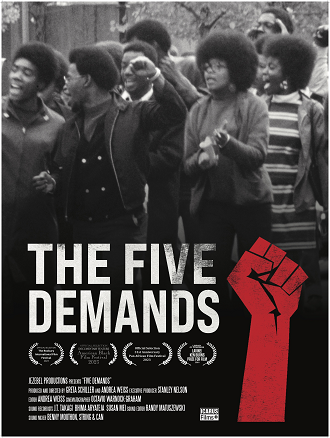
The Five Demands 2023
Distributed by Icarus Films, 32 Court St., 21st Floor, Brooklyn, NY 11201; 800-876-1710
Produced by Stanley Nelson
Directed by Greta Schiller and Andrea Weiss
Streaming, 74 mins
College - General Adult
Activism; BIPOC (Black, Indigenous, and People of Color); Education
Date Entered: 07/18/2023
Reviewed by Laura Harris, Web Services & Distance Learning Librarian, SUNY OswegoThe Five Demands attempts to capture the zeitgeist of the City College of New York (CCNY) from about 1965-1970. The film focuses on the racial composition of the student body, and attempts made to diversify that population. Three topics form the main narrative: the creation of the “Search for Education, Elevation, and Knowledge” (SEEK) program, the occupation of the campus in 1969, and the implementation of open admissions.
In the mid-1960s, about 97% of CCNY students were white. The college is located in Harlem, a historically Black neighborhood in New York City. Dr. Allen Ballard, a Black faculty member at CCNY, was one of many who hoped to see a college more representative of its community. The SEEK program was intended to enroll Black and Puerto Rican students and provide them with the support to succeed at CCNY.
The college’s president, Buell Gallagher, helped to recruit several notable Black scholars as teachers for SEEK. These scholars included June Jordan, Audre Lorde, Toni Cade Bambara, Addison Gayle, and Adrienne Rich. SEEK alumni that were interviewed for the film spoke about how meaningful these instructors were to them. Not only did these teachers help them to better express themselves, but they gave many students a sense of confidence, importance, and social responsibility.
The students were also influenced by the significant national and global issues of the time, such as the Vietnam War, the Civil Rights movement, and the assassination of Dr. Martin Luther King, Jr. In October 1968, a group of 10 students submitted a list of five demands to President Gallagher:
- A separate school of Black & Puerto Rican Studies
- A separate orientation student for Black & Puerto Rican students.
- A voice for SEEK students in the setting of all guidelines for the SEEK program, including the hiring and firing of all personnel
- That the racial composition of all entering classes reflect the Black & Puerto Rican population of New York City’s high schools
- That Black and Puerto Rican history, and Spanish language be a requirement for all education majors.
It should be noted that the film’s story centers around the fourth demand, to the exclusion of the other demands.
It’s unclear how President Gallagher responded to these demands. Gallagher is often portrayed positively in the documentary: Dr. Ballard described him as a “pioneer in African American education” and some alumni described him as “progressive” and “sympathetic.” In archival video footage, Gallagher states that he had been working on various demands for 3 months, and other demands for 6 months. Whatever Gallagher’s actions, however, they were not communicated to students or personnel. In other archival video footage, SEEK director Dr. Alan Young notes that no response was received when the demands were submitted in October, nor in January, when President Gallagher “was asked to agree in principle to the validity of the demands, and set up the means by which negotiation could take place.”
As a result, the students staged a campus takeover in April 1969. Gallagher began negotiating in earnest, and it appeared that a tentative agreement had been reached. It’s implied, however, that city and state officials obstructed Gallagher, and he resigned. A détente was eventually reached when it was decided to implement open admissions throughout the City University of New York (CUNY) system. (In this case, open admissions means that any student who received a high school diploma in New York City could attend a CUNY school.) It’s unclear why open admissions was the eventual solution, as the protesting students were not strongly in support of this solution. It also seems that the system was unprepared to implement open admissions; as former SEEK counselor Fran Giteles summarized, “They were totally unprepared for happened because they were just flooded.” Giteles and others also note that there were many proposed budget cuts to the CUNY system at the same time.
While CUNY and other public colleges and universities, would continue to grapple with open admissions over the coming years, the filmmakers logically chose to end the story when the discussion outgrew the grassroots efforts of CCNY students. The remainder of the film has a celebratory tone. The valedictorian and salutatorian (a SEEK program graduate) of a recent class give speeches celebrating the hard work and diversity of the student body. This is echoed by speaker Michelle Obama. Footage of the 50th anniversary of the student takeover is shown, where alumni are recognized for their work in revolutionizing CCNY and the City University of New York system as a whole.
This film is recommended for adolescents and adults. The film might be useful in undergraduate classes focused on very specific topics, such as student activism in the 1960s, or a graduate level class on higher education leadership. However, the film has a broader appeal that would likely be of interest to many, especially those living in New York City.
Content warning: the film has some archival photos and video footage that depict police brutality. There is also a scene with archival footage of an early elementary classroom; in that scene, the teacher grabs, pulls, and kicks a Black boy.
Published and licensed under the Creative Commons Attribution 4.0 license. Anyone can use these reviews, so long as they comply with the terms of the license.